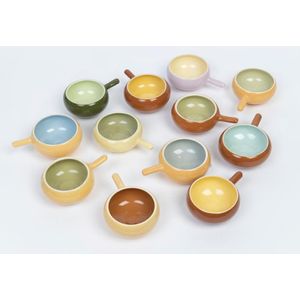Martin Boyd Slipware Ramekins: 12 Glazed Collection in Earth Tones
A collection of twelve glazed slipware ramekins by Martin Boyd, in shades of yellow, tan, green and brown, incised signatures to base, the largest 5.5 cm high
You must be a subscriber, and be logged in to view price and dealer details.
Subscribe Now to view actual auction price for this item
When you subscribe, you have the option of setting the currency in which to display prices to $Au, $US, $NZ or Stg.
This item has been sold, and the description, image and price are for reference purposes only.
- Incised - A record of a name, date or inscription, or a decoration scratched into a surface, usually of a glass or ceramic item with a blunt instrument to make a coarse indentation. Compare with engraving where the surface is cut with a sharp instrument such as a metal needle or rotating tool to achieve a fine indentation.
- Slipware Pottery - When people think of how pottery is made, they usually imagine clay being thrown on a wheel. This is still a common method used by studio potters, together with coiling and carving. However, these techniques are time-consuming and so for factory production, a quicker and cheaper method is essential. Such a method is slip casting.
In slip casting, a clay slurry is poured into a plaster of Paris mould. When the clay has dried, the mould is taken apart and the pot allowed to dry further. It may then be fired, decorated and glazed.
Most factory produced mid 20th century pottery was slipware. Huge quantities were maufactured for the 'popular ornaments' market.
This item has been included into following indexes:
